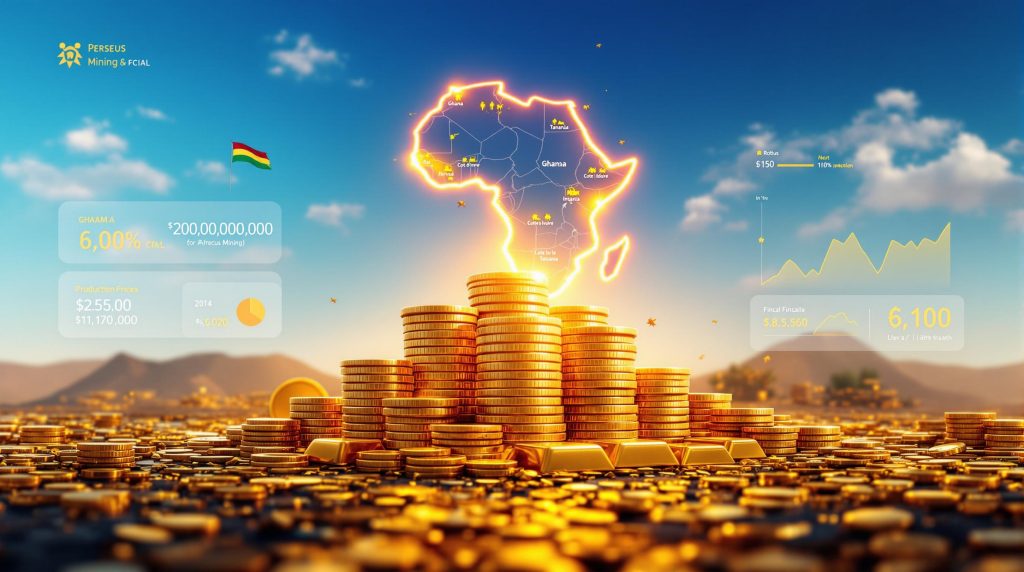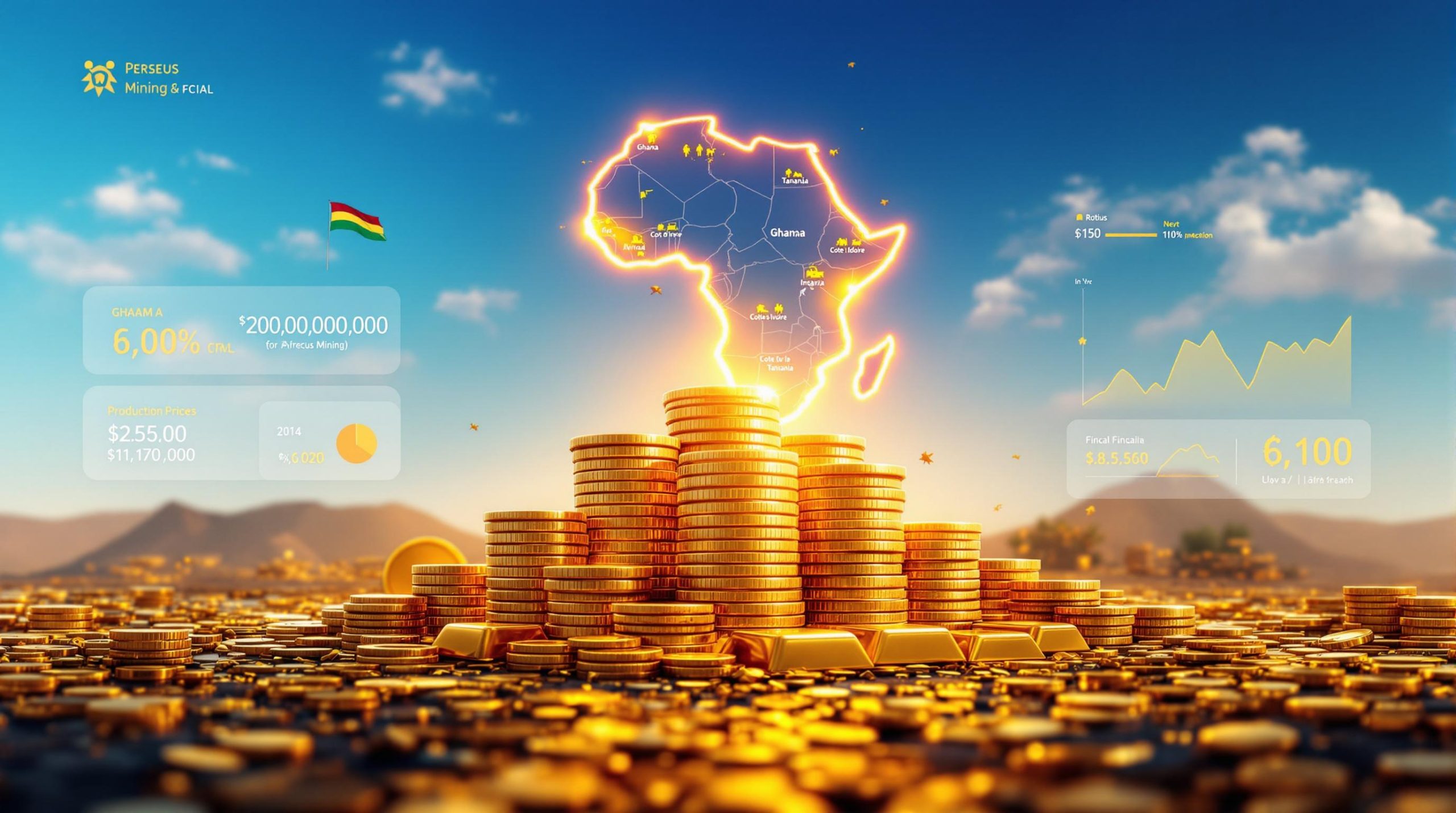What Drives Perseus Mining's Resilient Growth in West Africa?
How Has Perseus Mining Navigated Rising Operational Costs?
Perseus Mining has demonstrated remarkable adaptability in a challenging cost environment for gold producers across West Africa. While inflationary pressures have impacted the entire industry, Perseus has managed to maintain better-than-expected performance through strategic planning and operational discipline.
What Are the Key Cost Pressures for Gold Producers in West Africa?
The gold mining sector in West Africa faces significant cost challenges that have intensified over recent years. These challenges stem from multiple sources that directly impact operational margins and investment planning.
Fuel price volatility represents one of the most significant operational cost drivers, with diesel typically accounting for 15-20% of production expenses. This volatility has been particularly pronounced following supply chain disruptions and regional instability that affects fuel logistics across West African operations.
Labor costs have also seen substantial increases, with skilled mining professionals commanding premium salaries due to competition between expanding operations. The talent pool for experienced mining engineers, geologists, and specialized technicians remains limited relative to the growing number of projects in the region.
Currency dynamics create another layer of complexity. The strengthening of West African currencies against the US dollar has resulted in margin compression for producers with predominantly local costs but dollar-denominated revenue. This effect has been particularly pronounced in Ghana and Côte d'Ivoire, where local currencies have shown surprising resilience.
| Cost Metric | Perseus Q4 FY25 | Industry Trend (Past 2 Years) |
|---|---|---|
| AISC (USD/oz) | $1,417 | +15–20% global avg. increase |
| Cash & Bullion (USD mn) | $827 | Not sector-standard |
Perseus's All-In Sustaining Cost (AISC) reached US$1,417/oz during Q4 FY25, representing a 17% increase from the previous quarter. While this uptick is substantial, it remained within 5% of analyst forecasts, demonstrating the company's relative predictability in an unpredictable cost environment.
Notably, royalty expenses have increased in line with higher gold prices analysis, as most jurisdictions in West Africa employ percentage-based royalty structures. This creates a partial natural hedge – higher gold prices increase revenue but also trigger higher royalty payments.
What Strategic Cost Control and Capital Discipline Practices Stand Out?
Perseus's approach to cost management has yielded impressive results despite industry-wide inflationary pressures. The company achieved a full-year FY25 AISC of $1,235/oz, outperforming its own guidance and positioning it favorably compared to sector peers with similar operational profiles.
Looking forward, the company has provided FY26 production forecasts of 400,000–440,000 oz at AISC $1,460–$1,620/oz. This guidance reflects both realistic cost assessments and a commitment to transparency with investors.
Capital deployment for FY26 includes approximately $450 million allocated to strategic growth initiatives:
- CMA Underground (Yaouré): $80 million to develop Côte d'Ivoire's first underground gold mine
- Edikan stripping: $20 million for waste removal to access higher-grade ore
- Nyanzaga (Tanzania): $340 million for continued development of this cornerstone project
CEO Jeff Quartermaine has emphasized that Perseus prioritizes cash generation over simple production volume, noting: "Our priority is to maximize cash production. In extending mine life, we've focused on maintaining the right balance between scale, cost, and margin."
This strategic philosophy differentiates Perseus from competitors who may pursue growth at the expense of margins. The company has successfully shifted its operational mindset from "more ounces" to "more profitable ounces," allowing it to weather cost volatility more effectively.
"Maximizing cash production and balancing scale, cost, and margin underpins Perseus's strategy." – CEO perspective
The company's tailings facility expansion at Yaouré and environmental upgrades at Edikan represent proactive investments that both satisfy regulatory requirements and improve operational efficiency. These investments help prevent costly disruptions that might otherwise impact production continuity.
How Does Perseus Position Itself Amid Gold Market Volatility?
What Macro Trends Are Influencing Gold Sector Performance?
The gold market continues to benefit from several powerful macro trends that support both price stability and potential appreciation. Understanding these trends provides crucial context for evaluating Perseus's strategic positioning.
Central bank buying remains a dominant theme, with 2024 seeing near-record gold purchases according to World Gold Council data. This institutional demand represents a structural shift in global reserve management practices, with countries diversifying away from traditional currency reserves.
| Macro Factor | 2024 Update |
|---|---|
| Central Bank Buying | Near-record gold purchases |
| Inflation | Persistent; supports gold value |
| ETF Flows | Volatile |
The persistent negative real interest rate environment, despite nominal rate increases in many economies, continues to support gold prices. International Monetary Fund projections indicate continued monetary accommodation across major economies, suggesting this favorable backdrop will persist.
Reserve diversification by sovereign wealth funds and central banks has accelerated, particularly among emerging market nations seeking to reduce dollar dependency. This trend provides a solid demand floor during periods of price volatility.
For producers like Perseus, this macro environment emphasizes the importance of maintaining cash margin preservation. The company's operational strategy aligns well with these market conditions, focusing on profitability rather than production volume alone.
How Is Perseus Responding to Investment Market Shifts?
Investor expectations in the gold sector have evolved significantly, with emphasis shifting from production growth targets to cash generation, operational predictability, and risk management. Perseus has positioned itself to benefit from these changing priorities.
The company maintains a robust financial position with $827 million in cash and bullion, no debt, and $300 million in undrawn credit facilities. This liquidity profile provides significant operational flexibility and insulates the company from potential market disruptions.
Perseus's Nyanzaga project in Tanzania exemplifies its approach to development financing. With forecast AISC of $1,230–$1,330/oz, the project offers attractive margins at current gold market investment outlook. More importantly, the company plans to self-fund the estimated $520 million capital requirement without equity dilution, preserving shareholder value.
Institutional investors increasingly value jurisdictional diversification and operational stability, areas where Perseus has established credibility. The company's track record of nearly five consecutive years meeting or exceeding production guidance has strengthened its reputation among investors seeking predictable performance.
Why Is Jurisdictional Diversification Critical in West Africa?
What Geopolitical and Fiscal Trends Affect Mining Operations?
West Africa's mining landscape has witnessed significant geopolitical shifts that underscore the importance of operational diversification. Military coups and political transitions have created uncertainty in several countries, although the mining sector has generally demonstrated resilience through these changes.
Changing tax policies represent another layer of complexity, with governments seeking to increase their share of resource revenues. CEO Jeff Quartermaine has acknowledged this reality: "With youth populations rising fast, host governments are under pressure to fund education and employment, making increased taxation of miners an inevitable policy lever."
The region is experiencing youth-driven economic reform movements that advocate for greater local benefits from natural resource extraction. This demographic pressure has translated into evolving regulatory frameworks that mining companies must navigate.
Governments throughout West Africa face competing objectives – attracting investment capital while ensuring adequate domestic benefits. This balancing act manifests in several regulatory trends:
- Accelerated permitting timelines to encourage development
- Stricter local hiring mandates and capacity building requirements
- Gradual increases in tax and royalty obligations
- Greater scrutiny of environmental compliance and rehabilitation plans
Companies operating in this environment must demonstrate both technical competence and social awareness to navigate these evolving expectations successfully.
How Has Perseus Structured Its Geographic and Operational Presence?
Perseus has strategically diversified its asset portfolio across multiple jurisdictions to mitigate country-specific risks. This approach provides natural hedging against regulatory or political disruptions in any single location.
The company's operational footprint spans three countries:
- Ghana: Edikan mine (open-pit operation)
- Côte d'Ivoire: Sissingué and Yaouré mines (open-pit operations with underground expansion at Yaouré)
- Tanzania: Nyanzaga project (development stage)
| Asset | Country | Status | Key Details |
|---|---|---|---|
| Edikan | Ghana | Operating | Open-pit |
| Sissingué | Côte d'Ivoire | Operating | Open-pit |
| Yaouré | Côte d'Ivoire | Expansion | CMA Underground; permit pending |
| Nyanzaga | Tanzania | Development | First gold: Jan 2027 target |
Perseus maintains additional West African exposure through its 17.8% equity stake in Predictive Discovery, now valued at approximately $140 million – double the company's initial investment. This strategic holding provides optionality and potential pipeline opportunities without requiring immediate capital deployment or management attention.
The CMA Underground development at Yaouré represents a notable milestone as Côte d'Ivoire's first underground gold mining operation. This project demonstrates Perseus's ability to pioneer new technical approaches within established jurisdictions, building on existing relationships and infrastructure.
If political risk heightens in one nation, Perseus's regional mix provides a built-in hedge against local disruptions.
This diversified approach means that a regulatory change or political event in any single jurisdiction would impact only a portion of the company's overall operations. This structure has proven attractive to investors seeking exposure to West African gold without concentrated country risk.
What Sets Perseus Apart in Capital Management and Project Delivery?
How Does Perseus Approach Capital Allocation and Shareholder Returns?
Perseus demonstrates a disciplined approach to capital management that balances growth investment with shareholder returns. The company's FY26 capital expenditure of $450 million will be funded entirely through internal cash generation, avoiding dilutive financing or excessive leverage.
The company has already completed $73 million of a planned $100 million share buyback program, with full completion targeted by September 2025. This approach to returning capital demonstrates confidence in the company's valuation and future prospects while providing tangible returns to shareholders.
Perseus targets a cash margin of $500/oz based on a conservative long-term gold price assumption of $2,400/oz. This margin-focused approach prioritizes profitability over simple production growth, creating resilience against cost inflation and price volatility.
The company's financial position features zero net debt and substantial liquidity, enabling development without requiring shareholder dilution. This conservative balance sheet management contrasts with competitors who have leveraged aggressively to fund expansions, leaving them vulnerable to market disruptions.
Capital allocation decisions reflect a balance between:
- Maintaining existing operations at optimal efficiency
- Developing high-return expansion opportunities
- Returning excess capital to shareholders
- Preserving financial flexibility for opportunistic acquisitions
This balanced approach has positioned Perseus to develop a four-mine portfolio without overleveraging or excessive equity issuance, protecting shareholder interests while enabling growth.
What Are the Company's Unique Project Execution and Hedging Methods?
Perseus employs a distinctive Engineering and Construction contract model that differs from the industry-standard EPC (Engineering, Procurement, and Construction) approach. The company manages procurement and employment processes directly, yielding both cost savings and enhanced local benefits.
CEO Jeff Quartermaine has highlighted this advantage: "Perseus already has all of its processes in place for local procurement and local employment." This established framework accelerates project development and strengthens community relationships.
The company's development readiness is evident across its portfolio:
-
Nyanzaga: This Tanzanian project remains on track with permitting processes progressing and construction start imminent. The Framework and Shareholder Agreement is scheduled for execution this quarter, with first gold production targeted for January 2027.
-
CMA Underground: Set to become Côte d'Ivoire's first underground gold mine, this Yaouré expansion awaits final regulatory approvals expected imminently. The project represents both technical innovation and strategic mine life extension.
Perseus employs a sophisticated hedging strategy to manage price risk while preserving upside potential. The company currently has 240,000 oz hedged over a three-year period, representing approximately 16% of forecast production. This moderate hedge ratio provides downside protection without significantly capping upside potential.
The hedging structure utilizes zero-cost collars, combining purchased put options with sold call options at a $2,600/oz strike price. CEO Quartermaine explains: "Our current approach uses zero-cost collars, we buy downside protection at $2,600/oz and sell upside above that, locking in cash flow without premium cost."
This approach differs from many peers who employ either no hedging (accepting full price risk) or fixed-price forward sales (eliminating upside potential). Perseus's balanced method preserves financing flexibility while providing revenue certainty for a portion of production.
What Role Does ESG Play in Perseus's Resilience?
How Does ESG Policy Impact Operational Continuity and Permitting?
Perseus has integrated environmental, social, and governance considerations into its operational strategy, recognizing that strong ESG performance serves as both risk mitigation and competitive advantage in West Africa.
Proactive environmental management is evident in the company's tailings facility upgrades at Yaouré and environmental compliance initiatives at Edikan. These investments demonstrate commitment to evolving regulatory standards while preventing potential operational disruptions that might result from compliance failures.
The company's local procurement and employment integration extends beyond regulatory requirements, building genuine social license in host communities. This approach has tangible benefits for permitting and approvals, as demonstrated by the company's track record of regulatory cooperation.
Perseus recognizes that effective ESG performance provides concrete operational benefits:
- Accelerated permitting processes through established trust relationships
- Reduced risk of community conflicts or operational disruptions
- Enhanced ability to attract and retain skilled local workforce
- Greater resilience against regulatory changes or new requirements
These advantages translate into tangible financial benefits through reduced project delays, lower compliance costs, and stronger community support during challenging periods.
The company's approach aligns with evolving investor expectations regarding ESG performance in emerging markets. Rather than treating environmental and social initiatives as separate from operational strategy, Perseus has integrated these considerations into core business planning.
Additionally, Perseus has made significant investments in mine reclamation innovation across its operations, setting new standards for environmental responsibility in the region.
What Is the Current Investment Thesis for Perseus Mining?
Why Do Investors Gravitate Toward Perseus Amid Industry Changes?
Perseus offers a compelling investment proposition based on disciplined capital management, operational diversification, and consistent execution. The company has established credibility through nearly five consecutive years of meeting or exceeding production guidance.
Efficient capital discipline distinguishes Perseus from many sector peers, with growth funded through internal cash generation rather than dilutive equity raises or excessive leverage. This approach preserves shareholder value while enabling strategic development.
The company's geographic diversification across Ghana, Côte d'Ivoire, and Tanzania provides natural hedging against country-specific risks. This portfolio approach allows investors to gain exposure to West African gold potential without concentrated jurisdictional exposure.
Strong cash flows support both development initiatives and shareholder returns, with the ongoing share buyback program demonstrating commitment to capital returns. The company's target of $500/oz cash margin at $2,400/oz gold provides attractive profitability potential.
Asset longevity receives strategic focus through mine life extensions and a robust project pipeline. The CMA Underground expansion at Yaouré and development of Nyanzaga in Tanzania create visible production growth over multiple years.
Strategic development planning and sophisticated hedging create resilience against both price volatility and political uncertainties. The company's measured approach to development sequencing ensures adequate funding without overextending resources.
Furthermore, the company has been increasingly focused on mineral beneficiation in Africa, adding value to its operations beyond mere extraction.
Investment Thesis Summary Table
| Investment Pillar | Perseus Approach |
|---|---|
| Cash Generation | Prioritized over volume growth |
| Self-Funded Expansion | No new equity or debt needed |
| Operational Track Record | 5 years of meeting/exceeding guidance |
| Jurisdictional Diversity | Ghana, Côte d'Ivoire, Tanzania (and pipeline) |
| Shareholder Returns | Buybacks, cash margin focus |
| ESG Commitment | Regulatory and social risk mitigation |
Value creation receives support from both ongoing cash returns and a conservative financing approach. The company's ability to develop its asset portfolio without shareholder dilution or balance sheet overleveraging demonstrates financial discipline.
What Lessons Do Perseus's Strategic Choices Offer for Gold Miners?
Perseus's approach provides valuable insights for other gold producers operating in emerging markets. The company's experience demonstrates the importance of multi-country risk management, preventing excessive concentration in any single jurisdiction.
Disciplined project sequencing allows Perseus to maintain financial flexibility while pursuing growth opportunities. Rather than attempting simultaneous development across multiple assets, the company prioritizes projects based on both financial returns and risk profiles.
The company's readiness for both cost shocks and market rallies demonstrates the value of operational flexibility. By maintaining margin focus rather than volume targets, Perseus can adjust to changing market conditions without sacrificing profitability.
Self-funding represents a core strategic advantage, enabling development without dilution or excessive leverage. This approach contrasts with competitors who may accept significant shareholder dilution to fund ambitious growth targets.
Ready to Capture Early Mining Investment Opportunities?
Don't miss another significant ASX mineral discovery – Discovery Alert's proprietary Discovery IQ model provides real-time alerts on potential transformative opportunities before the broader market reacts. Explore how major mineral discoveries have generated substantial returns by visiting Discovery Alert's discoveries page and gain your market-leading advantage today.




